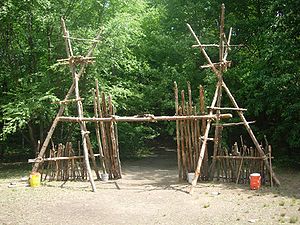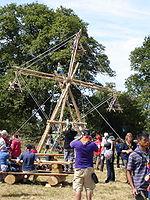
Pioneering
Encyclopedia

Lashing knot
A lashing is an arrangement of rope used to secure two or more items together in a somewhat rigid manner. Lashings are most commonly applied to timber poles, and are commonly associated with the scouting movement and with sailors....
and knot
Knot
A knot is a method of fastening or securing linear material such as rope by tying or interweaving. It may consist of a length of one or several segments of rope, string, webbing, twine, strap, or even chain interwoven such that the line can bind to itself or to some other object—the "load"...
s to create a structure. Pioneering can be used for constructing small items such as camp gadgets up to larger structures such as bridges and towers. These may be recreational, decorative, or functional.
Pioneering is used to teach practical skills, teamwork and problem solving. It is widely used in Scouting
Scouting
Scouting, also known as the Scout Movement, is a worldwide youth movement with the stated aim of supporting young people in their physical, mental and spiritual development, that they may play constructive roles in society....
and Girl Guiding. Many Scout and Guide groups train their members in pioneering skills and construct projects, both small and large. In camp, Scouts may construct functional items like tables, camp dressers and gadgets, as well as decorative camp gateways. Pioneering is a common merit badge in many countries, and was required for the Eagle Scout rank in the 1920s and 1930s.
The name comes from the 18th and 19th century military engineers who went ahead of an army to "pioneer" a route, which could involve building bridges and towers with rope and timber (for example the Royal Pioneer Corps
Royal Pioneer Corps
The Royal Pioneer Corps was a British Army combatant corps used for light engineering tasks.The Royal Pioneer Corps was raised on 17 October 1939 as the Auxiliary Military Pioneer Corps. It was renamed the Pioneer Corps on 22 November 1940...
).
Pioneering skills include Knot tying
Knot tying
thumb|right|[[The Ashley Book of Knots]] is considered the definitive work on the topicKnot tying consists of the techniques and skills employed in tying a knot in rope, nylon webbing, or other articles. The proper tying of a knot can be the difference between an attractive knot and a messy one,...
(tying ropes together), lashing
Lashing knot
A lashing is an arrangement of rope used to secure two or more items together in a somewhat rigid manner. Lashings are most commonly applied to timber poles, and are commonly associated with the scouting movement and with sailors....
(tying spars together with rope), whipping
Whipping knot
A whipping knot or whipping is a binding of twine around the end of a rope to prevent the fibres of the rope from unravelling.When a rope is cut, there is a natural tendency for the cut end to fray. A whipping is one way to try to prevent this, by applying multiple turns of twine tightly around...
(binding the end of a rope with thin twine), splicing
Rope splicing
Rope splicing in ropework is the forming of a semi-permanent joint between two ropes or two parts of the same rope by partly untwisting and then interweaving their strands. Splices can be used to form a stopper at the end of a line, to form a loop or an eye in a rope, or for joining two ropes...
(joining or binding the end of a rope using its own fibres), and skills related to the use, care and storage of ropes, spars and related pioneering equipment.
Basic knots
There are a number of basic knots used in pioneering:- Square knotReef knotThe reef knot or square knot is an ancient and simple binding knot used to secure a rope or line around an object. Although the reef knot is often seen used for tying two ropes together, it is not recommended for this purpose due to potential instability of the knot.A reef knot is formed by tying...
- Two half hitches
- Taut-line hitchTaut-line hitchThe taut-line hitch is an adjustable loop knot for use on lines under tension. It is useful when the length of a line will need to be periodically adjusted in order to maintain tension. It is made by tying a rolling hitch around the standing part after passing around an anchor object...
- Timber hitchTimber hitchThe timber hitch is a knot used to attach a single length of rope to a piece of wood. This knot is easily undone after use.To make the knot, pass the rope completely around the wood. Pass the running end around the standing part, then through the loop that you have just formed. Make three turns...
- Clove hitchClove hitchA clove hitch is a type of knot. Along with the bowline and the sheet bend, it is often considered one of the most essential knots. A clove hitch is two successive half-hitches around an object. It is most effectively used as a crossing knot. It can be used as a binding knot, but is not...
- BowlineBowlineThe bowline is an ancient and simple knot used to form a fixed loop at the end of a rope. It has the virtues of being both easy to tie and untie. The bowline is sometimes referred as King of the knots because of its importance...
- SheepshankSheepshankThe sheepshank is a type of knot that is used to shorten a rope or take up slack. This knot is not stable. It will fall apart under too much load or too little load.The knot has several features which allow a rope to be shortened:...
- Sheet bendSheet bendThe sheet bend is a bend, that is, a knot that joins two ropes together. Doubled, it is effective in binding lines of different diameter or rigidity securely together, although it has a tendency to work loose when not under load.The sheet bend is related in structure to the bowline...
Basic lashings
- Square lashing, used to join two poles at a right angle
- Diagonal lashing, used when securing two diagonals to each other
- Round lashing, used to join two poles in a straight line
- Sheer lashing, used to join two poles in a scissors shape
Pioneering structures

- A-FrameA-FrameAn A-frame is a basic structure designed to bear a load in a lightweight economical manner. The simplest form of an A-frame is two similarly sized beams, arranged in a 45-degree or greater angle, attached at the top...
- The basis of many tower structures. The horizontal member of the A-frame also makes a convenient springing point for a deck such as a table-top. - Trestle - Used as a modular element for building bridges and towers. Also used as a 'chariot' for inter-Patrol chariot races. Often referred to as X-Trestle or H-Trestle
- Tripod - As end supports for swingbridges, dining tables, etc. and as the basis for the hourglass tower. A tripod is not considered secure unless its legs are staked or otherwise attached to the ground.
Pioneering projects

- Camp gateways
- Bridges
- Dressers
- Tables
- Camp gadgets
- Chairs
- Benches
- Flagpoles
- Towers
- RaftsKon-Tiki (Scouting Event)Kon-Tiki refers to one of two annual Scout raft-building competitions, held in Cape Town and Gauteng in South Africa.Named after Thor Heyrdahl's Kon-tiki expedition of 1947, teams compete to build and live on a raft for a weekend. Support crew or "Fringe" teams compete in other, ground-based...
- Aerial runways
- Swinging Ships
- Merry-Go-Rounds
- Ferris Wheel
- Catapults
- Ballistas
- Trebuchets
- Swing Sets
- See Saws
See also
- List of knots
- WoodcraftWoodcraftWoodcraft is a recreational/educational program devised by Ernest Thompson Seton in 1902, for young people based on camping, outdoor skills and woodcrafts. Thompson Seton's Woodcraft ideas were incorporated into the early Scout movement, but also in many other organisations in many countries.In the...
- Miniature pioneeringMiniature PioneeringMiniature Pioneering or Model Pioneering is an art form featuring the miniaturized version of pioneering construction. This technique was originally used by Boy Scouts to create a model for campsite planning...
External links
- Scoutbase - UK Scout Association website, with lots of projects
- Ropes and Poles - Pioneering blog - growing collection of unusual projects
- PioneeringProjects.org - Large collection of pioneering projects and links to resources
- pioneeringmadeeasy - Large collection of pioneering projects for the scouts free of charge
- Scouting Resources - Pioneering projects and lashings

